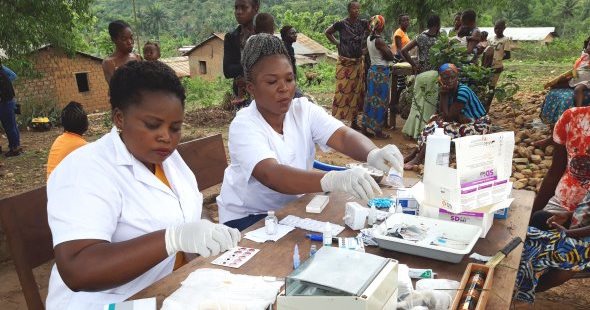Transboundary collaboration to eliminate HAT

What is this project?
This project is focused on making rapid diagnostic tests (RDTs) for human African trypanosomiasis (HAT, also known as sleeping sickness) available to populations in remote and hard-to-reach areas, in support of disease elimination efforts in the challenging transboundary region of Bas Congo – which includes the Kongo Central province of the Democratic Republic of the Congo (DRC), Republic of Congo and Angola.
Why are we working on it?
HAT is targeted by WHO for elimination as a public health problem by 2020, and for global elimination by 2030. However, in remote and hard-to-reach places, people are often unable to get a reliable diagnosis, putting achievement of these targets at risk.
Few HAT cases have been reported recently in Bas Congo, making elimination of the disease in the region distinctly feasible. However, given the transboundary nature of the region, achieving the elimination goals relies on activities in the three countries being coordinated and harmonized. Strengthening diagnostic capacity in this challenging area is essential to significantly impact disease control and prevention, and accelerate elimination.
What does it involve?
Project activities in the three countries have included characterization of health facilities, capacity building, which includes health facility upgrades and training, and the introduction of novel screening and diagnostic tools.
The diagnostic algorithm now being implemented ensures that no infected patient goes undetected. This algorithm includes initial testing of patients suspected of having HAT at the first point at which they seek healthcare, with a novel RDT that was co-developed by FIND; this is critical for early diagnosis, enabling people who are found positive to be referred for confirmatory testing and to receive treatment before the disease progresses into the brain.
What do we expect to achieve?
In addition to supporting HAT elimination efforts, this project will leave a legacy of stronger health systems and processes, including procurement of laboratory equipment and consumables, training of personnel, quality assurance and sensitization of communities in the Bas Congo region.
The project was designed to be both sustainable and replicable, and other African countries including Uganda, Chad and Guinea have already adopted a similar approach to support HAT elimination. Uganda is now on the brink of achieving elimination, with only one indigenous case reported since July 2018. HAT RDTs are now being used for case finding and surveillance in 16 sub-Saharan African countries.
What is the timescale?
This project commenced in 2014 and is expected to run until HAT elimination in the Bas Congo region is achieved. Current plans are to continue working in Angola and the Republic of Congo until 2021.
Partners and funding
From 2014 to 2018, our work on this project was supported with funding from the Bill & Melinda Gates Foundation, UK aid from the British people, the German Federal Ministry of Education and Research (BMBF) through KfW, the Swiss Agency for Development and Cooperation (SDC), the Canton of Geneva, the Belgian Institute of Tropical Medicine (ITM), supported by the Belgian Technical Cooperation, and others, and with significant in-kind contributions by the governments of the three countries.
From 2019, overall coordination of the project in Kongo Central, DRC, is being led by ITM. The Programme National de Lutte contre la Trypanosomiase Humaine Africaine (PNLTHA) is responsible for the day-to-day management, with ongoing support from FIND. We will continue coordinating the project in the Republic of Congo and Angola with further support from the Canton of Geneva.
Technical partners include the DRC Institut National de Recherche Biomédicale (INRB), supported by experts from Makerere University, Uganda.
More information
For more information please contact us.
Quick links

